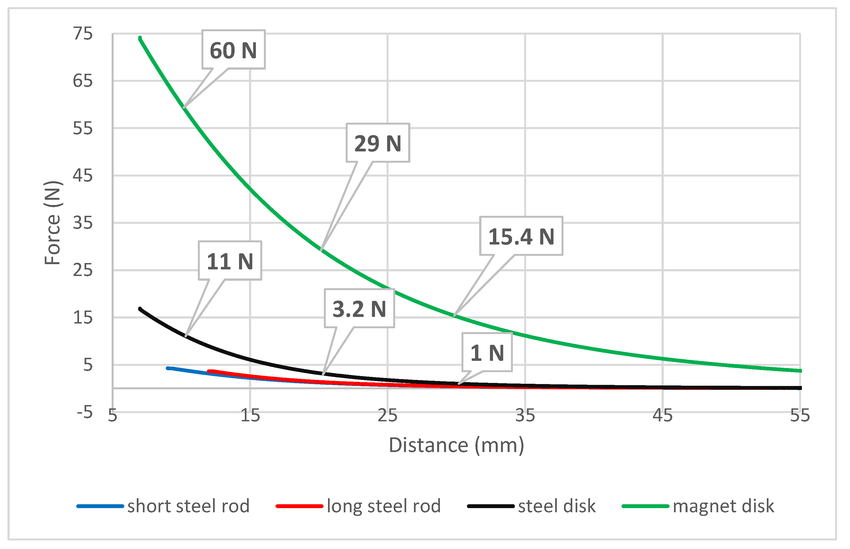The Stanford Magnet Calculator
Select a Shape:
Discs/Cylinders
Blocks
Rings
Select
In
In
Select
In
In
In
Select
In
In
In
Resulting Force(lbf):
Please report any troubles, concerns or suggestions about this calculator
To: [email protected]Calculating the pull force of a magnet helps determine its strength and suitability for specific applications. The pull force is influenced by various factors, including the type of magnet, its size, shape, and the material it’s interacting with. Our Magnet Pull Force Calculator provides an easy-to-use tool to estimate the force a magnet can exert under ideal conditions, allowing you to make informed decisions for your projects.
The pull force of a magnet is influenced not only by its shape and size but also by the distance between the magnet and the ferrous material. This relationship is illustrated by the pull-gap force.
The pull-gap curve graphically depicts how the pulling force of a magnet changes with varying air gap distances between the magnet and a target material. In an experiment, a magnet is placed in direct contact with a flat, thick steel piece, and the air gap is gradually increased. The pull-gap curve shows how the magnetic force weakens as the air gap increases.
For example, a neodymium magnet with a 45 kg pull-force requires a force of 45 kilograms to detach from the target material when in direct contact. As the air gap grows, the force needed to separate the magnet from the target decreases. The curve below shows how the pull force varies between a 45 kg pull-force neodymium magnet and different target materials: a short steel rod, a long steel rod, a steel disk, and a disk magnet.

For additional magnet strength calculations and technical support, visit our homepage.
For a deeper understanding of magnetism and its applications, explore our related articles. Learn about the science behind magnetic fields, the difference between permanent magnets and electromagnets, and how various materials affect pull force.
How Is the Pull Force of Magnets Determined?
How to Determine North And South Pole of Magnet?
Magnet Grades: A Deep Dive into Pull Force, Gauss, and N Numbers
Simplify your magnet selection process with the Stanford Magnets Magnet Pull Force Calculator. Whether you're working with neodymium magnets, samarium cobalt, or ferrite, our calculator helps you select the right magnet for your needs with just a few clicks. Try it now and experience the convenience of making precise magnet calculations effortlessly.
At Stanford Magnets, our deep knowledge of magnetic fundamentals enables us to deliver optimal solutions for your unique needs. Understanding the key principles of magnetism is essential for choosing the right materials and applications. Here are some core magnetic units. We are your trusted partner for high-quality magnetic solutions.
The strength of a magnetic field produced by an electric current or a magnet. It is a measure of the force exerted by a magnetic field on moving charges or magnetic materials.
The total magnetic field passing through a surface, representing the quantity of magnetism in a given area. It depends on the strength of the magnetic field and the area it spans.
A measure of the strength and orientation of a magnet or a current loop. It describes the torque a magnet experiences in an external magnetic field and represents the magnet’s ability to align with the field.
A property of a material that indicates how easily it can become magnetized when exposed to a magnetic field. It measures the material’s ability to support the formation of a magnetic field within itself.
A dimensionless quantity that indicates how much a material will become magnetized when exposed to an external magnetic field. It measures the degree to which a material is magnetically responsive. These terms form the foundation of understanding magnetic phenomena, from materials' interactions with magnetic fields to the strength and behavior of magnetic forces.
Send us an Inquiry now to find out more Information and the latest prices, thanks!
United States
Drop files here or